Full Orchestra Music
Clarinet Catalog
- p.1 (Ad - Be)
- p.2 (Be - Br)
- p.3 (Br - De)
- p.4 (Du - Ha)
- p.5 (Ha - Ha)
- p.6 (Hi - Ma)
- p.7 (Ma - Mu)
- p.8 (Ne - Ro)
- p.9 (Ro - St)
- p.10 (St - Wh)
- p.11 (Wi - Ze)
- Next >
-

-
Handel, Georg Frederic
Concertos for Organ & Orchestra Nos 13-16 (Koopman) [Breitkopf study score]
Classical. Includes HWV.295, HWV.296A, HWV.304 and HWV.305A.
Category: Orchestra Study Scores
Item: 124701
Grade:
Price: $21.95
Availability: Usually Ships in 24 Hours - View Shopping Cart
-

-
Handel, Georg Frederic
Concertos for Organ & Orchestra, op 4 (Koopman) [Breitkopf study score]
Classical.
Category: Orchestra Study Scores
Item: 124700
Grade:
Price: $21.95
Availability: Usually Ships in 24 Hours - View Shopping Cart
-

-
Handel, Georg Frederic
Concertos for Organ & Orchestra, op 7 (Koopman) [Breitkopf study score]
Classical.
Category: Orchestra Study Scores
Item: 124702
Grade:
Price: $23.95
Availability: Usually Ships in 24 Hours - View Shopping Cart
-

-
Handel, Georg Frederic
La Rejouissance, from the Royal Fireworks Music (Meyer)
Category: Orchestra Music
Item: 136682
Grade: Grade 2 - Late Elementary
Price: $60.00
Availability: Ships in 10 to 15 Days - View Shopping Cart
-

-
Handel, Georg Frederic
La Rejouissance, from the Royal Fireworks Music - full score (Meyer)
Category: Orchestra Music
Item: 136683
Grade: Grade 2 - Late Elementary
Price: $7.00
Availability: Ships in 10 to 15 Days - View Shopping Cart
-

-
Handel, Georg Frederic
La Rejouissance, from the Royal Fireworks Music - full score (Meyer)
Category: Orchestra Full Scores
Item: 136683
Grade: Grade 2 - Late Elementary
Price: $7.00
Availability: Ships in 10 to 15 Days - View Shopping Cart
-

-
Handel, Georg Frederic
Overture in Dm, from Concerto Grosso, op 3, no 5 (Isaac)
Category: Orchestra Music
Item: 136745
Grade: Grade 4 - Intermediate
Price: $73.00
Availability: Ships in 10 to 15 Days - View Shopping Cart
-

-
Handel, Georg Frederic
Overture in Dm, from Concerto Grosso, op 3, no 5 - full score (Isaac)
Category: Orchestra Full Scores
Item: 136746
Grade: Grade 4 - Intermediate
Price: $7.00
Availability: Ships in 10 to 15 Days - View Shopping Cart
-

-
Handel, Georg Frederic
Overture in Dm, from Concerto Grosso, op 3, no 5 - full score (Isaac)
Category: Orchestra Music
Item: 136746
Grade: Grade 4 - Intermediate
Price: $7.00
Availability: Ships in 10 to 15 Days - View Shopping Cart
-

-
Handel, Georg Frederic
Sarabande & March (Leidig)
Category: Orchestra Music
Item: 136725
Grade: Grade 3 - Early Intermediate
Price: $45.00
Availability: Ships in 10 to 15 Days - View Shopping Cart
-

-
Handel, Georg Frederic
Sarabande & March - full score (Leidig)
Category: Orchestra Full Scores
Item: 136726
Grade: Grade 3 - Early Intermediate
Price: $5.00
Availability: Ships in 10 to 15 Days - View Shopping Cart
-

-
Handel, Georg Frederic
Sarabande & March - full score (Leidig)
Category: Orchestra Music
Item: 136726
Grade: Grade 3 - Early Intermediate
Price: $5.00
Availability: Ships in 10 to 15 Days - View Shopping Cart
-

-
Handel, Georg Frederic
Xerxes
Dover reprint of an 1884 Chrysander edition, with the addition of an Italian libretto. 123 pages. Full score only - parts not included. 9780486449654. 0486449653.
Category: Orchestra Full Scores
Item: 064196
Grade:
Price: $19.95
Availability: Usually Ships in 24 Hours - View Shopping Cart
-

-
Harbinson, William
Lake Dance
Category: Orchestra Music
Item: 136820
Grade: Grade 5 - Early Advanced
Price: $68.00
Availability: Ships in 10 to 15 Days - View Shopping Cart
-

-
Harbinson, William
Lake Dance - full score
Category: Orchestra Full Scores
Item: 136821
Grade: Grade 5 - Early Advanced
Price: $8.00
Availability: Ships in 10 to 15 Days - View Shopping Cart
-

-
Harbinson, William
Lake Dance - full score
Category: Orchestra Music
Item: 136821
Grade: Grade 5 - Early Advanced
Price: $8.00
Availability: Ships in 10 to 15 Days - View Shopping Cart
-

-
Haydn, Franz Joseph
Concerto in Eb, Hob.VIIe:1 (Gerlach et al)
Category: Orchestra Full Scores
Item: 097739
Grade:
Price: $47.95
Availability: Usually Ships in 24 Hours - View Shopping Cart
-

-
Haydn, Franz Joseph
Creation, The [Dover study score]
Reprint of early C.F. Peters edition.
Category: Orchestra Study Scores
Item: 043430
Grade:
Price: $14.95
Availability: Usually Ships in 24 Hours - View Shopping Cart
-

-
Haydn, Franz Joseph
Lord Nelson Mass, Mass in Time of War [Paukenmass] [Dover full score]
Category: Orchestra Full Scores
Item: 021839
Grade:
Price: $19.95
Availability: Usually Ships in 24 Hours - View Shopping Cart
-
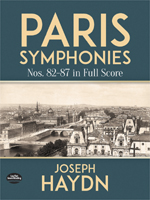
-
Haydn, Franz Joseph
Paris Symphonies Nos 82-87
Category: Orchestra Full Scores
Item: 112956
Grade:
Price: $29.95
Availability: Usually Ships in 24 Hours - View Shopping Cart
-

-
Haydn, Franz Joseph
Paukenmesse - Mass in Time of War, Hob.XXII:9 (Landon/Fuessl)
Category: Orchestra Study Scores
Item: 083524
Grade:
Price: $21.95
Availability: Usually Ships in 24 Hours - View Shopping Cart
-

-
Haydn, Franz Joseph
Symphonies No 93-98 - London Symphonies [Dover full score]
Dover reprint of an early edition. Parts not included - full score only.
Category: Orchestra Full Scores
Item: 029719
Grade:
Price: $24.95
Availability: Usually Ships in 24 Hours - View Shopping Cart
-
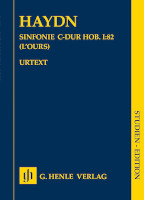
-
Haydn, Franz Joseph
Symphony No 82 in C, Hob.I:82 - The Bear [Paris No 1] (Lippe/Scheideler) [study score]
Classical. Nicknamed The Bear. Joseph Haydn's so-called Paris Symphonies were composed in 1785 and 1786 for the masonic lodge "Soci‚t‚ Olympique" in Paris, which ran a large orchestra and organised regular concerts. These six works are notable for their artful motivic work and playful wit. Haydn here pays tribute both to the discerning taste of the Paris audience and to the excellent abilities of the musicians in the orchestra. These symphonies rapidly became famous and popular throughout Europe,...
Read More
Category: Orchestra Study Scores
Item: 125003
Grade:
Price: $16.95
Availability: Ships in 10 to 15 Days - View Shopping Cart
-
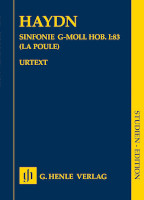
-
Haydn, Franz Joseph
Symphony No 83 in Gm, Hob.I:83 - The Hen [Paris No 2] (Nakano/Scheideler) [study score]
Classical. Joseph Haydn's so-called Paris Symphonies were composed in 1785 and 1786 for the masonic lodge "Soci‚t‚ Olympique" in Paris, which ran a large orchestra and organised regular concerts. These six works are notable for their artful motivic work and playful wit. Haydn here pays tribute both to the discerning taste of the Paris audience and to the excellent abilities of the musicians in the orchestra. These symphonies rapidly became famous and popular throughout Europe, thanks to editions ...
Read More
Category: Orchestra Study Scores
Item: 125004
Grade:
Price: $16.95
Availability: Ships in 10 to 15 Days - View Shopping Cart
-
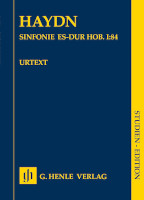
-
Haydn, Franz Joseph
Symphony No 84 in Eb, Hob.I:84 [Paris No 3] (Lippe/Scheideler) [study score]
Classical. Joseph Haydn's so-called Paris Symphonies were composed in 1785 and 1786 for the masonic lodge "Soci‚t‚ Olympique" in Paris, which ran a large orchestra and organised regular concerts. These six works are notable for their artful motivic work and playful wit. Haydn here pays tribute both to the discerning taste of the Paris audience and to the excellent abilities of the musicians in the orchestra. These symphonies rapidly became famous and popular throughout Europe, thanks to editions ...
Read More
Category: Orchestra Study Scores
Item: 125005
Grade:
Price: $16.95
Availability: Ships in 10 to 15 Days - View Shopping Cart
-

-
Haydn, Franz Joseph
Symphony No 85 in Bb, Hob.I:85 - The Queen [Paris No 4] (Nakano/Scheideler) [study score]
Classical. Joseph Haydn's so-called Paris Symphonies were composed in 1785 and 1786 for the masonic lodge "Soci‚t‚ Olympique" in Paris, which ran a large orchestra and organised regular concerts. These six works are notable for their artful motivic work and playful wit. Haydn here pays tribute both to the discerning taste of the Paris audience and to the excellent abilities of the musicians in the orchestra. These symphonies rapidly became famous and popular throughout Europe, thanks to editions ...
Read More
Category: Orchestra Study Scores
Item: 125006
Grade:
Price: $16.95
Availability: Ships in 10 to 15 Days - View Shopping Cart
-

-
Haydn, Franz Joseph
Symphony No 86 in D, Hob.I:86 [Paris No 5] (Gerlach/Lippe/Scheideler) [study score]
Classical. Joseph Haydn's so-called Paris Symphonies were composed in 1785 and 1786 for the masonic lodge "Soci‚t‚ Olympique" in Paris, which ran a large orchestra and organised regular concerts. These six works are notable for their artful motivic work and playful wit. Haydn here pays tribute both to the discerning taste of the Paris audience and to the excellent abilities of the musicians in the orchestra. These symphonies rapidly became famous and popular throughout Europe, thanks to editions ...
Read More
Category: Orchestra Study Scores
Item: 125007
Grade:
Price: $16.95
Availability: Ships in 10 to 15 Days - View Shopping Cart
-

-
Haydn, Franz Joseph
Symphony No 87 in A, Hob.I:87 [Paris No 6] (Nakano/Scheideler) [study score]
Classical. Joseph Haydn's so-called Paris Symphonies were composed in 1785 and 1786 for the masonic lodge "Societe Olympique" in Paris, which ran a large orchestra and organised regular concerts. These six works are notable for their artful motivic work and playful wit. Haydn here pays tribute both to the discerning taste of the Paris audience and to the excellent abilities of the musicians in the orchestra. These symphonies rapidly became famous and popular throughout Europe, thanks to editions ...
Read More
Category: Orchestra Study Scores
Item: 125008
Grade:
Price: $16.95
Availability: Ships in 10 to 15 Days - View Shopping Cart
-

-
Haydn, Franz Joseph
Symphony No 88 in G, Hob.I:88 (Friesenhagen) [study score]
Classical. Haydn probably composed his Symphony no. 88 in G major in 1787, just one year after the six so-called Paris symphonies. It was written, together with its sister work, the F-major Symphony no. 89, for the violinist Johann Tost, who sold it to the Parisian publisher Sieber. In both works, Haydn continues the compositional achievements of the Paris symphonies: mastery of orchestration, richness of musical ideas and details, and an idiosyncratic, multicoloured use of the wind section (whic...
Read More
Category: Orchestra Study Scores
Item: 127101
Grade:
Price: $16.95
Availability: Usually Ships in 24 Hours - View Shopping Cart
-

-
Haydn, Franz Joseph
Symphony No 89 in F, Hob.I:89 (Friesenhagen) [study score]
Classical. According to his dating of the autograph, Haydn composed the Symphony no. 89 in F major in 1787, just one year after the six so-called Paris symphonies. It was written, together with its sister work, the G-major Symphony no. 88, for the violinist Johann Tost, who sold it to the Parisian publisher Sieber. In both works, Haydn continues the compositional achievements of the Paris symphonies: mastery of orchestration, richness of musical ideas and details, and an idiosyncratic, multicolou...
Read More
Category: Orchestra Study Scores
Item: 127102
Grade:
Price: $16.95
Availability: Usually Ships in 24 Hours - View Shopping Cart
-

-
Haydn, Franz Joseph
Symphony No 90 in C, Hob.I:90 (Fiesenhagen) [study score]
Classical. Haydn's three Symphonies nos. 90-92 might rightly be dubbed his "Paris Symphonies Part II", as they were commissioned in 1788/89, likewise by the Soci‚t‚ Olympique, for which Haydn had already composed his six "Paris Symphonies" nos. 82-87 just a few years earlier. Ironically enough, Haydn would later sell these three a second time to Prince von Oettingen-Wallerstein who requested he "receive 3 new symphonies from him". Regardless of such mercantile entanglements, Haydn shows himself t...
Read More
Category: Orchestra Study Scores
Item: 129721
Grade:
Price: $16.95
Availability: Usually Ships in 24 Hours - View Shopping Cart
-

-
Haydn, Franz Joseph
Symphony No 91 in Eb, Hob.I:91 (Fiesenhagen) [study score]
Classical. Haydn's three Symphonies nos. 90-92 might rightly be dubbed his "Paris Symphonies Part II", as they were commissioned in 1788/89, likewise by the Soci‚t‚ Olympique, for which Haydn had already composed his six "Paris Symphonies" nos. 82-87 just a few years earlier. Ironically enough, Haydn would later sell these three a second time to Prince von Oettingen-Wallerstein who requested he "receive 3 new symphonies from him". Regardless of such mercantile entanglements, Haydn shows himself t...
Read More
Category: Orchestra Study Scores
Item: 129722
Grade:
Price: $16.95
Availability: Usually Ships in 24 Hours - View Shopping Cart
-

-
Haydn, Franz Joseph
Symphony No 92 in G, Hob.I:92 (Fiesenhagen) [study score]
Classical. Haydn's three Symphonies nos. 90-92 might rightly be dubbed his "Paris Symphonies Part II", as they were commissioned in 1788/89, likewise by the Soci‚t‚ Olympique, for which Haydn had already composed his six "Paris Symphonies" nos. 82-87 just a few years earlier. Ironically enough, Haydn would later sell these three a second time to Prince von Oettingen-Wallerstein who requested he "receive 3 new symphonies from him". Regardless of such mercantile entanglements, Haydn shows himself t...
Read More
Category: Orchestra Study Scores
Item: 129723
Grade:
Price: $16.95
Availability: Usually Ships in 24 Hours - View Shopping Cart
-

-
Haydn, Franz Joseph
Symphony No 93 in D, Hob.I:93 - Oxford [London No 1] (Zahn/Gruber/Muhle) [study score]
Classical. Haydn's three Symphonies nos. 90-92 might rightly be dubbed his "Paris Symphonies Part II", as they were commissioned in 1788/89, likewise by the Soci‚t‚ Olympique, for which Haydn had already composed his six "Paris Symphonies" nos. 82-87 just a few years earlier. Ironically enough, Haydn would later sell these three a second time to Prince von Oettingen-Wallerstein who requested he "receive 3 new symphonies from him". Regardless of such mercantile entanglements, Haydn shows himself t...
Read More
Category: Orchestra Study Scores
Item: 129724
Grade:
Price: $16.95
Availability: Usually Ships in 24 Hours - View Shopping Cart
-
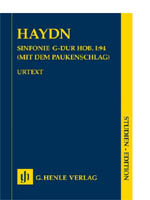
-
Haydn, Franz Joseph
Symphony No 94 in G, Hob.I:94 - Surprise [London No 2] (Zahn/Muhle) [study score]
Classical. The twelve "London Symphonies" comprise the sublime final statement of Haydn's symphonic oeuvre. They were written for the London impresario Johann Peter Salomon, and Haydn himself conducted their premieres during his lengthy stays in the English metropolis in 1791/92 and 1794/95. To this day, the G-major symphony, first performed in March 1792, numbers among Haydn's most popular works. It owes its English nickname "Surprise" to the striking tutti chords in the Andante, which apparent...
Read More
Category: Orchestra Study Scores
Item: 132763
Grade:
Price: $16.95
Availability: Usually Ships in 24 Hours - View Shopping Cart
-

-
Haydn, Franz Joseph
Symphony No 95 in Cm, Hob.I:95 [London No 3] (Zahn/Gruber/Muhle) [study score]
Classical. The twelve "London Symphonies" comprise the sublime final statement of Haydn's symphonic ouvre. They were written for the London impresario Johann Peter Salomon, and Haydn himself conducted their premieres during his lengthy stays in the English metropolis in 1791/92 and 1794/95. Probably composed in the winter of 1791/92, the Symphony in D major no. 93 was, with its easily accessible (butby no means simple!) musical structure, perfectly tailored to London tastes, which demanded melodi...
Read More
Category: Orchestra Study Scores
Item: 129981
Grade:
Price: $16.95
Availability: Usually Ships in 24 Hours - View Shopping Cart
-

-
Haydn, Franz Joseph
Symphony No 96 in D, Hob.I:96 [London No 4] (Gruber) [study score]
Classical. The twelve "London Symphonies" comprise the sublime final statement of Haydn's symphonic oeuvre. They were written for the London impresario Johann Peter Salomon, and Haydn himself conducted their premieres during his lengthy stays in the English metropolis in 1791/92 and 1794/95. Hailing from 1791, the Symphony in D major no. 96 numbers among the first symphonies written in and for London. The epithet given to it by posterity, "The Miracle", was bestowed erroneously, for the miracle -...
Read More
Category: Orchestra Study Scores
Item: 129268
Grade:
Price: $16.95
Availability: Usually Ships in 24 Hours - View Shopping Cart
-

-
Haydn, Franz Joseph
Symphony No 97 in C, Hob.I:97 [London No 5] (Zahn/Muehle) [study score]
Classical. The twelve "London Symphonies" comprise the sublime final statement of Haydn's symphonic oeuvre. They were written for the London impresario Johann Peter Salomon, and Haydn himself conducted their premieres during his lengthy stays in the English metropolis in 1791/92 and 1794/95. In his C-major symphony, performed for the first time in May 1792, Haydn bestowed a particular honour on Salomon, who was also the leader of the orchestra: At the end of the minuet, he wrote a little solo in...
Read More
Category: Orchestra Study Scores
Item: 132772
Grade:
Price: $16.95
Availability: Usually Ships in 24 Hours - View Shopping Cart
-

-
Haydn, Franz Joseph
Symphony No 97 in C, Hob.I:97 [London No 5] (Zahn/Muehle) [study score]
Classical. The twelve "London Symphonies" comprise the sublime final statement of Haydn's symphonic oeuvre. They were written for the London impresario Johann Peter Salomon, and Haydn himself conducted their premieres during his lengthy stays in the English metropolis in 1791/92 and 1794/95. In his C-major symphony, performed for the first time in May 1792, Haydn bestowed a particular honour on Salomon, who was also the leader of the orchestra: At the end of the minuet, he wrote a little solo in...
Read More
Category: Orchestra Music
Item: 132772
Grade:
Price: $16.95
Availability: Usually Ships in 24 Hours - View Shopping Cart
-

-
Haydn, Franz Joseph
Symphony No 98 in Bb, Hob.I:98 [London No 6] (Zahn/Muehle) [study score]
Classical. The twelve "London Symphonies" comprise the sublime final statement of Haydn's symphonic oeuvre. They were written for the London impresario Johann Peter Salomon, and Haydn himself conducted their premieres during his lengthy stays in the English metropolis in 1791/92 and 1794/95. The first performance of the B-flat-major Symphony no. 98 in 1792 was so successful that the two allegro outer movements even had to be repeated. Haydn led the performance - as was customary - from a keyboar...
Read More
Category: Orchestra Study Scores
Item: 132773
Grade:
Price: $16.95
Availability: Usually Ships in 24 Hours - View Shopping Cart
-

-
Haydn, Franz Joseph
Symphony No 98 in Bb, Hob.I:98 [London No 6] (Zahn/Muehle) [study score]
Classical. The twelve "London Symphonies" comprise the sublime final statement of Haydn's symphonic oeuvre. They were written for the London impresario Johann Peter Salomon, and Haydn himself conducted their premieres during his lengthy stays in the English metropolis in 1791/92 and 1794/95. The first performance of the B-flat-major Symphony no. 98 in 1792 was so successful that the two allegro outer movements even had to be repeated. Haydn led the performance - as was customary - from a keyboar...
Read More
Category: Orchestra Music
Item: 132773
Grade:
Price: $16.95
Availability: Usually Ships in 24 Hours - View Shopping Cart
-

-
Haydn, Franz Joseph
Symphony No 99 in Eb, Hob.I:99 [London No 7] (Walter/Volckmar-Waschk) [study score]
Classical. Haydn arrived in London at the beginning of February 1794 for his second stay in England. At this point in time, the Symphony in E-flat major Hob. I:99 had already been completed and was premiered on 10 February. Audiences and the press were enthusiastic, as a review from the following day shows, "It is one of the grandest efforts of art that we ever witnessed. [...] - It was received with rapturous applause." Thus, an exceptional work in every sense, also for the first use of clarinet...
Read More
Category: Orchestra Study Scores
Item: 132774
Grade:
Price: $16.95
Availability: Usually Ships in 24 Hours - View Shopping Cart
-

-
Haydn, Franz Joseph
Symphony No 99 in Eb, Hob.I:99 [London No 7] (Walter/Volckmar-Waschk) [study score]
Classical. Haydn arrived in London at the beginning of February 1794 for his second stay in England. At this point in time, the Symphony in E-flat major Hob. I:99 had already been completed and was premiered on 10 February. Audiences and the press were enthusiastic, as a review from the following day shows, "It is one of the grandest efforts of art that we ever witnessed. [...] - It was received with rapturous applause." Thus, an exceptional work in every sense, also for the first use of clarinet...
Read More
Category: Orchestra Music
Item: 132774
Grade:
Price: $16.95
Availability: Usually Ships in 24 Hours - View Shopping Cart
-

-
Haydn, Franz Joseph
Symphony No 100 in G, Hob.I:100 - Military [London No 8] (Walter/Volckmar-Waschk) [study score]
Classical. Haydn arrived in London at the beginning of February 1794 for his second stay in England. Two movements of the Symphony in G major Hob. I:100 had already been completed by then, and the finished work was premiered on 31 March. The trumpet fanfare in the second movement and the use of "janissary" percussion gave the symphony its nickname "Military Symphony," which Haydn himself even used. Its success in London was enormous; in 1794/95 alone, the work was performed nine times and thus qu...
Read More
Category: Orchestra Study Scores
Item: 132775
Grade:
Price: $17.95
Availability: Usually Ships in 24 Hours - View Shopping Cart
-

-
Haydn, Franz Joseph
Symphony No 100 in G, Hob.I:100 - Military [London No 8] (Walter/Volckmar-Waschk) [study score]
Classical. Haydn arrived in London at the beginning of February 1794 for his second stay in England. Two movements of the Symphony in G major Hob. I:100 had already been completed by then, and the finished work was premiered on 31 March. The trumpet fanfare in the second movement and the use of "janissary" percussion gave the symphony its nickname "Military Symphony," which Haydn himself even used. Its success in London was enormous; in 1794/95 alone, the work was performed nine times and thus qu...
Read More
Category: Orchestra Music
Item: 132775
Grade:
Price: $17.95
Availability: Usually Ships in 24 Hours - View Shopping Cart
-

-
Haydn, Franz Joseph
Symphony No 101 in G, Hob.I:101 - Clock [London No 9] (Walter/Volckmar-Waschk) [study score]
Classical. Haydn arrived in London at the beginning of February 1794 for his second stay in England. By this time, he had completed three movements of the Symphony in D major Hob. I:101, and the finished work was premiered on 3 March. Even the members ofthe audience at the premiere took note of the pendulum-like accompanying figure in the second movement, which was in fact explicitly mentioned in a review: "The management of the accompaniments of the andante, though perfectly simple, was masterly...
Read More
Category: Orchestra Study Scores
Item: 132776
Grade:
Price: $17.95
Availability: Usually Ships in 24 Hours - View Shopping Cart
-

-
Haydn, Franz Joseph
Symphony No 101 in G, Hob.I:101 - Clock [London No 9] (Walter/Volckmar-Waschk) [study score]
Classical. Haydn arrived in London at the beginning of February 1794 for his second stay in England. By this time, he had completed three movements of the Symphony in D major Hob. I:101, and the finished work was premiered on 3 March. Even the members ofthe audience at the premiere took note of the pendulum-like accompanying figure in the second movement, which was in fact explicitly mentioned in a review: "The management of the accompaniments of the andante, though perfectly simple, was masterly...
Read More
Category: Orchestra Music
Item: 132776
Grade:
Price: $17.95
Availability: Usually Ships in 24 Hours - View Shopping Cart
-
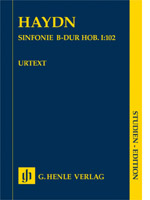
-
Haydn, Franz Joseph
Symphony No 102 in Bb, Hob.I:102 [London No 10] (Unverricht/Wilker) [study score]
Classical. The twelve "London Symphonies" comprise the sublime final statement of Haydn's symphonic ouvre. They were written for the London impresario Johann Peter Salomon, and Haydn himself conducted their premieres during his lengthy stays in the English metropolis in 1791/92 and 1794/95. The energetic, surging B-flat-major Symphony no. 102 belongs to the group of the last three symphonies premiered in early 1795. Exceptionally, Haydn here dispenses with the clarinets that are otherwise general...
Read More
Category: Orchestra Study Scores
Item: 132131
Grade:
Price: $16.95
Availability: Usually Ships in 24 Hours - View Shopping Cart
-

-
Haydn, Franz Joseph
Symphony No 103 in Eb, Hob.I:103 [London No 11] (Unverricht/Wilker) [study score]
Classical. The twelve "London Symphonies" comprise the sublime final statement of Haydn's symphonic ouvre. They were written for the London impresario Johann Peter Salomon, and Haydn himself conducted their premieres during his lengthy stays in the English metropolis in 1791/92 and 1794/95. The E-flat-major Symphony no. 103 was composed in 1795 as the penultimate of the London Symphonies. It owes its epithet to its unique beginning; a solo drumroll in the timpani ushers in the slow introduction. ...
Read More
Category: Orchestra Study Scores
Item: 132132
Grade:
Price: $17.95
Availability: Usually Ships in 24 Hours - View Shopping Cart
-
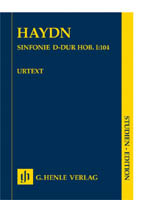
-
Haydn, Franz Joseph
Symphony No 104 in D, Hob.I:104 [London No 12] (Unverricht/Walker) [study score]
Classical. The twelve "London Symphonies" comprise the sublime final statement of Haydn's symphonic ouvre. They were written for the London impresario Johann Peter Salomon, and Haydn himself conducted their premieres during his lengthy stays in the English metropolis in 1791/92 and 1794/95. The D-major Symphony no. 104 was composed as the last of the "London Symphonies" in early 1795 and is not only the concluding work, but also the highlight of Haydn's symphonic output overall. It firmly establi...
Read More
Category: Orchestra Study Scores
Item: 129982
Grade:
Price: $17.95
Availability: Usually Ships in 24 Hours - View Shopping Cart
- p.1 (Ad - Be)
- p.2 (Be - Br)
- p.3 (Br - De)
- p.4 (Du - Ha)
- p.5 (Ha - Ha)
- p.6 (Hi - Ma)
- p.7 (Ma - Mu)
- p.8 (Ne - Ro)
- p.9 (Ro - St)
- p.10 (St - Wh)
- p.11 (Wi - Ze)
- Next >
More Options
- Use our Custom Order Page to special order items you can't find.
- Use our Catalog Order Page to order items from a printed catalog, or if you already know our catalog number for the item(s) you're interested in.
- And as always, feel free to E-mail us with your questions!
